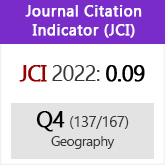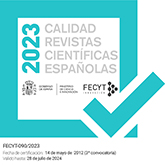Submissions
Submission Preparation Checklist
As part of the submission process, authors are required to check off their submission's compliance with all of the following items, and submissions may be returned to authors that do not adhere to these guidelines.- I've read Editorial CSIC's Good Practice Code and comply with all its guidelines.
- The Authorship, good publication practice and copyright transfer statement is filled and signed, and it'll be added to the submission.
- I have consulted and applied the journal's Research data policy.
- The article has not been previously published, and has not been sent to another journal for consideration.
- The submission is an original work and does not violate the copy and reproduction rights of other authored works. If necessary, the author has written permit for the reproduced work and a copy will also be submited.
- The person making the submission has been authorized by all the article authors to submit and act as their spokesperson in front of the journal during the review, editing and publishing processes.
- The text adheres to the length, format, references, citation of figures, tables and equations (if applicable), and bibliography requirements outlined in the journal guidelines.
-
Each of the authors has been identified including the following data:
- Given name (in full form) and family name(s).
- Email contact address.
- Country of professional activity.
- Institutional affiliation.
- Open Researcher and Contributor Identifier (ORCID).
- Role/roles according to the CRediT taxonomy (for more information see “Submissions/Authorship identification”). - TWO versions of the article are submitted, one in a Microsoft Word, LibreOffice, or compatible file, with all the author's information, and WITHOUT any graphical element (image or multimedia). A second file, in PDF format, which will include the content of the first one, and WITH all the graphical elements. In this version, any content that allows the identification of the authors in the text will be removed (name and affiliation, CRediT role/roles, self-citations, personal notes, etc.) and in the metadata of the file (check the "Properties" of the PDF in the "File" section). This second version will be the one used for the external evaluation. For the removal of metadata you can use specific software or one of the many free tools available on the Internet.
Author Guidelines
Download HERE the Good Practice Code in PDF
Download HERE the Authorship Form in PDF
GUIDELINES FOR THE SUBMISSION OF ORIGINALS
The journal Estudios Geográficos publishes two annual issues, with original research articles in Spanish or English. The submitted manuscripts must be original and unpublished, and may not have been approved or submitted for publication in another journal.
Manuscripts received will be reviewed firstly from the linguistic and formal point of view. Manuscripts with a poor quality level in this aspect or that do not conform to form will be returned without being reviewed.
In revising the manuscript, special attention will be placed on the use of language, which should be inclusive and non-sexist. In this sense, the language must be free of prejudices associated with race, functional diversity, gender, sexual orientation, beliefs, ideology or socioeconomic status, avoiding those expressions that involve stigmatization or discrimination of groups of people.
In the same way as Editorial CSIC, the journal Estudios Geográficos recommends the use of non-sexist language in texts submitted for publication, promoting inclusive linguistic formulas, as long as they do not modify the meaning of the expression.
For papers written in English, the guide published by the American Phylosophical Association can be used as a guideline.
Moreover, as part of the journal editorial policy, authors of research involving the participation of population (both children, youth or adults) should consider the relevance of incorporating sex or gender as a variable of analysis in the research design and establishing whether it has had an influence on the results obtained.
All the originals will be reviewed, according to the "peer" system, by at least two external experts, whose suggestions will be sent to the authors so that, if necessary, they make the pertinent modifications. The review method used is "double blind", maintaining the anonymity of both the author and the reviewers. The Editorial Board will analyze all the contributions and, taking into account the external evaluations, will decide its approval or rejection as well as the issue in which they will be published. The Editor-in-Chief may reject an article, without needing to review it, if it considers that it does not adapt to the guidelines or does not adapt to the content profile of the publication. The author will be informed about the acceptance or rejection of their contribution within a maximum period of six months.
Manuscripts submission
Accompanied by the completed and signed Authorship Form, originals should be submitted using the journal's website.
Submission of a manuscript implies that all co-authors have approved and agreed on the content of the submitted text, tables, graphic material, and any other supplementary materials provided. It is the responsibility of the corresponding author that all co-authors have the correct information on the submitted manuscript.
Electronic submission
The text must be submitted in a ‘.DOC’ or ‘.DOCX’ file, using two abbreviated title words as its name. Manuscripts in ‘.DOC’ or ‘.DOCX’ format with embedded images or multimedia files will be returned without processing.
A copy of the text, preferably, in «.PDF» format, for the evaluation. This copy will be a final version in all aspects, including all graphical elements, for the exception of not including the author’s name, the institutional affiliation, the e-mail address, nor the ORCID identifier. The author’s identity should not be recognisable from the references made to other papers, the acknowledgements or any other type of information.
Image files should be labelled accordingly to their content, placed together in a single folder labelled as above, and then compressed into a single ZIP file.
For example:
MétricasEspac.doc
MétricasEspac.pdf
MétricasEspac.zip (containing MétricasEspac-fig1.jpeg and MétricasEspac-tabla1.doc)
- Vector graphics exported from a drawing program should be saved as EPS (Encapsulated PostScript) format. Fonts used in the graphics (use Calibri) must be included. Suitable programs include Freehand, Illustrator and Corel Draw.
- Note that most presentation programs, such as Excel y Power Point, produce data that cannot be processed since they do not support the export of EPS data.
- Halftones images. Send colour illustrations as CMYK, and monotone in greyscale in TIFF or JPEG format. Whenever you use JPEG format, choose maximum quality instead of high compression in the options window. Suitable programs include Photoshop, Picture Publisher and Photo Paint, but others complying this indications, may also be suitable.
Table of resolutions for images and scans Original Mode Final resolution Minimum size Format Colour CMYK 300 dpi 15 × 15 cm TIFF or JPEG Monotone Greyscale 300 dpi 15 × 15 cm TIFF or JPEG B/W line drawing Line 900-1200 dpi 15 × 15 cm TIFF or EPS
All non-original material must mention the source. Contributors are responsible for obtaining permission to reproduce any material for which they do not hold copyright for worldwide publication in all forms and media, including electronic publication, and for ensuring that the appropriate acknowledgements are included in their text. If such permissions aren't submitted from the first moment, the Editor will require a copy of them once the manuscript is accepted for publication.
The manuscript must be organized as follows:
First page
- Title of the article in bolded lower case. The title must be concise and as informative as possible of its content.
- Complete name (first name and family name), institutional affiliation and postal address, telephone and fax number, e-mail address of the author(s) and ORCID identifier. The authors without this personal identifier must register in https://orcid.org to complete this data. In an article signed by several authors, the ORCID of each of them must appear. Do not add superscript to initial. Hyphenation of double family names is strongly recommended.
- Corresponding author, if there is more than one author.
- ABSTRACT: no longer than 250 words, describing research objectives, methodology, most outstanding results and main conclusions.
- KEYWORDS: six to eight keywords useful to describe the subject(s) of the article. Do not use words already present in the title.
- English and Spanish Title, Abstract and keywords: An English and Spanish translation of the title, abstract and keywords must be provided.
- Date of submission of the article.
Second page
- ABSTRACT: no longer than 250 words, describing research objectives, methodology, most outstanding results and main conclusions.
- KEYWORDS: six to eight keywords useful to describe the subject(s) of the article. Do not use words already present in the title.
- English and Spanish Title, Abstract and keywords: An English and Spanish translation of the title, abstract and keywords must be provided.
Text: length and sections
Text. The name of the author or his/her professional affiliation will not be indicated:
- Length: the text must not exceed 11,000 words that, with tables and figures (it will be understood by figure everything that is not text or table - figures themselves, maps, diagrams, 3D views, photographs, etc.) will be equivalent to 30 pages.
- Format for the presentation of works:
Font: Calibri.
Letter size: 11.
Line spacing: a space and a half (1.5), for all text with the only exception in the footnotes that will go to single line spacing.
Margins: 2.5 cm on all sides of the sheet.
Indentation: use paragraph format (never spacer), first line at 1.25
Alignment of the text: on the left. - Dashes: use larger dashes when equivalent to a comma (,) and the smallest dashes to separate dates and numbers [1976-78].
- Text: organize the article into clear, comprehensive parts, keeping subdivisions to a minimun. Main headings should be in bolded capital letters, first subheadings in bolded lower case, and subsequent headings, when needed, in italics. Do not number sections.
- It is suggested to divide the text in the following sections:
- Introduction. Set clearly the context and objectives of your work. Avoid mentioning the results of it.
- Sources and Methodology. Expose them in enough detail so that you can understand and reproduce the work. The methods that have already been published it is not necessary to explain it, just quoted. Only the substantial variations of previously published methods will be made explicit.
- Results. Express the results clearly and concisely.
- Discussion. Explore the significance of the results of the work, not just repeating them.
If appropriate, only a Results and discussion section will be written. - Conclusions. Express the conclusions of the work clearly and concisely in a short final section.
- Bibliographical references. Include only references cited in the text. And all the bibliography cited in the text will have to be conveniently referenced.
- Only in the full version in Word, the following elements will be added after the conclusions and before the bibliographic references:
- Supplementary files.
- Data availability.
- Acknowledgments.
- Declaration of competing interest.
- Funding sources.
- Authorship contribution statement.
- Reference list (begin new page).
- List of tables, figures, maps and multimedia files, including their numbering, title and captions.
Notes
- Notes should be used sparingly, only to provide absolutely essential additional information or clarification, when inclusion of that information in the text could be disruptive to the flow of the manuscript.
- Notes should be numbered sequentially in Arabic numerals as they appear in the text. To call for a note in the text, use a superscript, placed after the grammatical punctuation when applicable.
- Preferably, notes should be at the foot of the page, but a section with the text of all the notes could be included after the conclusions section and under the heading "Notes". Double space all entries, and list the notes sequentially.
- Each of the notes will have a maximum of 60 words. Notes that only contain bibliographic citations will be avoided.
- In-note reference citations must follow the same style as in-text citations.
- Examples:
- In-text call to a note:
"More studies have been carried out on this subject.1" - Citation in the Notes section:
1. In relation to the presented global interpretation and further reading about the demographic and economic structures, see especially Chapman (1990); Fernández-Miranda (1992); Delibes et al. (1994); Micó (1995); Risch (1995); Castro et al. (1998a; 1998b) and Molina and Cámara (2005).
- In-text call to a note:
Abbreviations, numbering, etc.
- In Spanish the Latin abbreviations will be written in italics (note that no comma follows the abbreviations). These include: e.g. / i.e. / ca. / in situ / vs / per se. In English, some Latin abbreviations are set in Roman type because they have been thoroughly incorporated in this language.
- Tables, figures, maps and other images and multimedia files should be numbered sequentially in the order that they appear in the text. Do not place figures or tables in the main body of the text, but at the end of the manuscript, as indicated above.
- References to figures, maps and other images and multimedia files in the main body of the text should be entered in full, or abbreviated when included between parentheses. Examples:
- "The spatial distribution is shown in Figure 3"
- "The Balearic Islands (Fig. 3) are separated from the Iberian Peninsula by…"
- References to tables in the main body of the text should always be entered in full. Examples:
- "The data in Table 1 show…"
- "By comparing the data (Table 1), the same conclusion…"
Units and numerical values
- When not required by the context, use International System units (km, m, kg, g, etc.).
- Use the symbol «t» for metric tons.
- For hours, minutes and seconds, use the symbols «h», «min» and «s», respectively.
- Use spaces between the quantity and the units (e.g. 2 m, 3 kg, 7 g). Exceptions: degree Celsius °C, latitude or longitude units and % (e.g. 37°C; 41°N, 1°17'E y 10%).
- Do not include spaces between the following symbols and numeric values: «>» (larger than), «<» (less than). Example: >7, <7.
- The point «.» should be used if the article is written in English, and the comma «,» if the language is Spanish as an indicator of decimals. No symbol should be used as a thousand separator (for example: 5200 o 10300).
- In tables and figures, whenever possible, the decimal will be rounded to a maximum of 2 digits. Example: 34,52 (Spanish), 27.09 (English).
Date format
- In the text, use a date format coherent with thee chosen language, Spanish or English. In the Reference list and for URL accession dates, use the sequence day/month/year, with the month fully written out. Separate URL accession dates with a slash «/» and no spaces. Example:
- In-text:
- “On the 14th of July 1789...”
- “On July 14th, 1789…”
- Reference list:
- Diario de Cádiz [DC], 7 July 1902
- URL accession date:
- [accessed 09/April/2010]
In-text reference citations
- Articles should conform to the APA style.
The Manual of style of the APA and their specifications employ an Author-Date citation system and always privilege the page number signalling for the textual citations and paraphrasing.- Textual quotes:
They reproduce the material exactly, without changes or additions. The author, year and page number must be indicated. If the cited source does not have pagination, then the paragraph number is written. A quote that is less than 40 words should be part of the main body of the text, in quotation marks and at the end in parentheses the data of the reference is indicated.
Models
- When analyzing the results and according the opinion of Machado (2010): "All participants…” (p. 74)
- When analyzing the results from the previous studies we found that: "All participants…” (Machado, 2010, p. 74)
A quote that is larger than 40 words should be detached from the main text and indented, without quotation marks, aligned to the left and with a margin of 2.54 cm or 5 tab spaces. All citations must go to double space.
Models
- Machiavelli (2011) in his work The Prince states the following:
Men, when they have a good of whom they believed to have an evil, they are forced more with their benefactor, the people quickly become more benevolent with him than if he had led him to the principality with his favors (p. 23).
- It is easier for the prince not to oppress the people and rule for them, because:
Men, when they have a good of whom they believed to have an evil, they are forced more with their benefactor, the people quickly become more benevolent with him than if he had led him to the principality with his favors (Maquiavelo, 2011, p. 23). - Paraphrasing
In these cases the idea of another is reproduced with own words. They follow the rules of the textual citation, with the exception of the use of quotes and quotations in a separate paragraph.
Models
- According to Huizinga (1952) are characteristic of the nobility good customs and distinguished manners, in addition to the practice of justice and the defense of the territories for the protection of the people.
- This is how the great monarchies of Spain, France and England appear, which tried to take over European hegemony by engaging in war on several occasions (Spielvogel, 2012, p. 425).
In the only cases where you can deliberately omit the page number is in the paraphrase and this when you are summarizing several ideas expressed throughout a work and not a particular idea easily locatable in the source cited.
- Textual quotes:
- Other citation guidelines:
- Two authors: Machado and Rodríguez (2015) affirm… or (Machado and Rodríguez, 2015, p._ )
- Three to five authors: when they are cited for first time all the surnames are named, then only the first one followed by the expression et al.: Machado, Rodríguez, Álvarez and Martínez (2015) assure that… / In other experiments the authors found that… (Machado et al., 2015)
- Six or more authors: since the first mention, only the first name of the first one, followed by the expression et al.
- Corporate or institutional author with acronyms or abbreviations: the first citation is placed the full name of the organization and then the abbreviation can be used. Organization of the Petroleum Exporting Countries (OPEC, 2016) and then OPEC (2016); World Health Organization (WHO, 2014) and then WHO (2014).
- Corporate or institutional author without acronyms or abbreviations: Instituto Cervantes (2012), (Instituto Cervantes, 2012).
- Two or more works in the same parenthesis: they are sorted alphabetically following the order in the list of references: Many studies confirm the results (Martínez, 2012; Portillo, 2014; Rodríguez y Zapata, 2015).
- Secondary sources or works found inside another source: Carlos Portillo (cited in Rodríguez, 2015)
- Ancient works: ancient and highly recognized religious texts, (Quran 4:1-3), Luke 3:2 (New Testament). They are not included in the reference list.
- Personal communications: personal letters, memorandums, electronic messages, etc. Manuela Álvarez (personal communication, June 4, 2010). They are not included in the reference list.
- Source without date; it is placed in parenthesis s.d., Alvarado (s.d.), Bustamante (s.d.).
- Anonymous source: the first words of the title of the work are cited (Management Report, 2013), Lazarillo de Tormes (2000).
- When citing contributions by the same author(s) within the same year, use a,b,c sequentially after the year: (Rodríguez, 2015a), (Rodríguez, 2015b). They are sorted by title alphabetically, in the list of references.
Reference list
References must be ordered alphabetically and hanging indent.
- Book: Surname, First Initial. Second Initial. (Year). Title. City, Country: Editorial.
- Book with editor: Surname, First Initial. Second Initial. (Ed.). (Year). Title. City, Country: Editorial.
- E-book: Surname, First Initial. Second Initial. (Year). Title. Retrieved from http://www…
- E-book with DOI: Surname, First Initial. Second Initial. (Year). Title. doi: xx
- Book chapter and anthologies where each chapter has a different author and a compiler or editor: Surname, First Initial. Second Initial. & Surname, First Initial. Second Initial. (Year). Chapter title. In Editor First Initial. Editor Second Initial. Editor Surname (Ed.), Title of the book (pp. xx-xx). City, Country: Editorial.
- Periodical publications in printed format: Surname, First Initial. Second Initial., Surname, First Initial. Second Initial., & Surname, First Initial. Second Initial. (Year). Article Title. Journal Title, Volume(issue), pp-pp.
- Periodical publications with DOI: Surname, First Initial. Second Initial., Surname, First Initial. Second Initial., & Surname, First Initial. Second Initial. (Year). Article Title. Journal Title, Volume(issue), pp-pp. doi: xx
- Periodical publications online: Surname, First Initial. Second Initial. (Year). Article Title. Journal Title, Volume(issue), pp-pp. Retrieved from http://www…
- Newspaper article in printed format: Surname, First Initial. Second Initial. (Year, Month Day). Article Title. Newspaper Title, pp-pp. Or without author: Article Title (Year, Month Day). Newspaper Title, pp-pp.
- Newspaper article online: Surname, First Initial. Second Initial. (Year, Month Day). Article Title. Newspaper Title, Retrieved from http://www…
- Degree Thesis: Surname, First Initial. Second Initial. (Year). Thesis Title (Undergraduate, master’s or doctoral dissertation). Name of the institution, City.
- Degree Thesis online: Surname, First Initial. Second Initial. (Year). Thesis Title (Undergraduate, master’s or doctoral dissertation). Name of the institution, City. Retrieved from http://www…
- Website: Surname, First Initial. Second Initial. (Year). Page Títle. Place of publication: Publishing House. Retrieved from http://www…
- Sources on CD: Surname, Initial. (Year). Title (edition) [CD-ROM]. Place of publication: Publishing House.
- Films: Producer Surname, Initial. (Producer), & Director Surname, Initial. (Director). (Year). Title of film [Motion picture]. Country where movie was produced: Name of Studio.
- Television Serie: Producer Surname, Initial. (Producer). (Year). Title of serie [Television serie]. Place: Name of Studio.
- Video: Producer Surname, Initial. (Producer). (Year). Title of serie [Video]. Place
- Podcast: Producer Surname, Initial. (Producer). (Year). Title of podcast [Audio podcast]. Retrieved from http://www…
- Internet forums, e-mail lists and other online communities: Author, (Year, Month Day). Message title [Description of the form] Retrieved from http://www…
Primary-source materials
- Primary-source (e.g., unpublished archival materials, including administrative records, letters, etc.) appear only in the text or notes, and are not duplicated in the Reference list section.
- If you are citing primary-source material from a published source, you must follow conventional citation rules in the text and in the References list.
Tables, figures and multimedia files
- It is considered as figure everything that is not text or table (figures themselves, maps, diagrams, 3D views, photographs, etc.).
- Multimedia files are mainly video and/or sound files.
- Tables, figures and multimedia material will be sent in separate files. In the place of the text in which they have to go will be Table, Figure or Multimedia File, followed by the corresponding Arabic number. Below, the title (brief) in capital letters. Both lines will be centered. In separate line, justified, without indent and font size 10 points, the source or any other information will be put.
Example:
Figure 3Source: national development plan 2010-2014 (DNP, 2010). Prepared by the author.
ASPECTS OF THE ANDEAN PARAMO - Tables, figures and multimedia files should be consecutively numbered with Arabic numerals.
- A list of tables, figures and multimedia files must be included at the end of the manuscript, including its title and explicative caption.
- All non-original tables, figures and multimedia files must indicate the source in the figure caption.
- Avoid very thin or very thick lines.
- Figures presenting the study area should include a small general map showing a larger geographical region. Always include a scale reference.
GUIDELINES FOR THE SUBMISSION OF NOTES
Sending in electronic format
A file containing the text in ".DOC" or ".DOCX" format, using two abbreviated words of the title as the name, should be sent using the journal's website.
NOTES will be between 3000 and 5000 words in length and will also be subject to peer review. These are works that do not necessarily have the classic structure of a scientific article, such as exploratory analyses, results of a relevant research project, studies of special interest, etc. From a formal point of view, they must comply with all the requirements set out for original articles, except for their length, the structure of the text and the absence of annexes in the case of NOTES: first and second pages (abstract and keywords in Spanish and English, etc.), format, acknowledgements, bibliographical references, notes, tables, figures, maps, files, abbreviations, citations, etc.
GUIDELINES FOR THE SUBMISSION OF REVIEWS
Sending in electronic format
A file containing the text in ".DOC" or ".DOCX" format, using two abbreviated words of the title as the name, should be sent using the journal's website.
REVIEWS should be approximately 900-1000 words in length and should be accompanied by the technical details of the work under review. The Editorial Board reserves the right not to publish reviews that it considers to use incorrect or formally inappropriate language or that do not follow the editorial line of the journal.
GUIDELINES FOR SUBMISSION OF ORIGINALS AND NOTES. FINAL ELEMENTS AFTER THE TEXT AND BEFORE THE BIBLIOGRAPHICAL REFERENCES.
This information will only be incorporated into the complete Word document (Doc or Docx). In addition, the following order and headings must be respected:
• Appendices to the article (optional) or Notes if any (optional, and it is preferable that the notes be at the foot of the page).
• Supplementary files (optional).
Brief description.
• Data availability (optional).
Brief description of the type of data deposited in repositories, name or identification code of the files, use and distribution license and URL.
• Acknowledgments (optional).
Do not include or mix with funding
• Declaration of competing interest (mandatory).
According to the model. In the absence of conflict of interest, the statement will be:
The authors of this article declare that they have no financial, professional or personal conflicts of interest that could have inappropriately influenced this work.
• Funding sources (optional).
Mention code and title of the project/grant/contract..., and developed name (optional acronym) of the financing entity.
Eg.: Work carried out within the framework of Project PG2019-097739-B-100, “The construction of a fiscal culture in León”, funded by the Ministry of Science and Innovation MICIN of Spain.
• Authorship contribution (mandatory).
This journal applies the CRediT taxonomy for identifying authorship contributions based on the assignment of specific roles to research articles. For more information see "Submissions/Authorship identification".
This information should be incorporated into the document, under the heading "Authorship contribution statement", located just before the bibliography, in the following format:
Authorship contribution statement:
Name and Surname author 01: Conceptualization, Formal analysis, Funding acquisition, Investigation, Methodology, Project administration, Writing – original draft, Writing – review & editing.
Name and Surname author 02: Conceptualization, Formal analysis, Investigation, Methodology, Writing – review & editing.
Etc., for each author, in case.
• Reference list.
SUBMISSION INSTRUCTIONS
Below you will find instructions for the following procedures:
- How to register at Estudios Geográficos
- How to send an original manuscript to Estudios Geográficos
- How to check a revision report and submit a revised version of a manuscript
How to register at Estudios Geográficos
1.- On the journal's website, click on the link "Register":
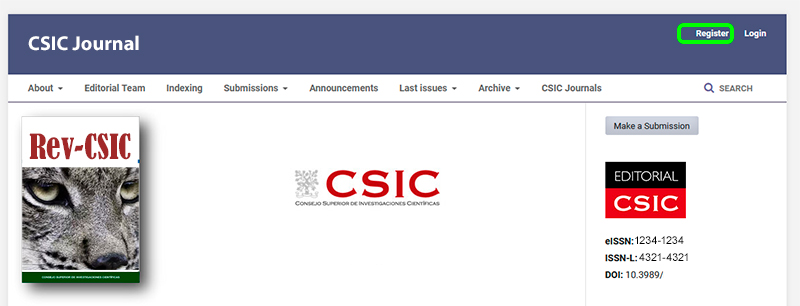
2.- On the registration page you will have to fill in all the fields (the "Family name" field is optional, although highly recommended) using lower case only for your email, username and password. After reading the Privacy Statement you will need to consent to the collection and storage of your data and complete the Captcha. Receiving notifications of new publications and notices is optional.
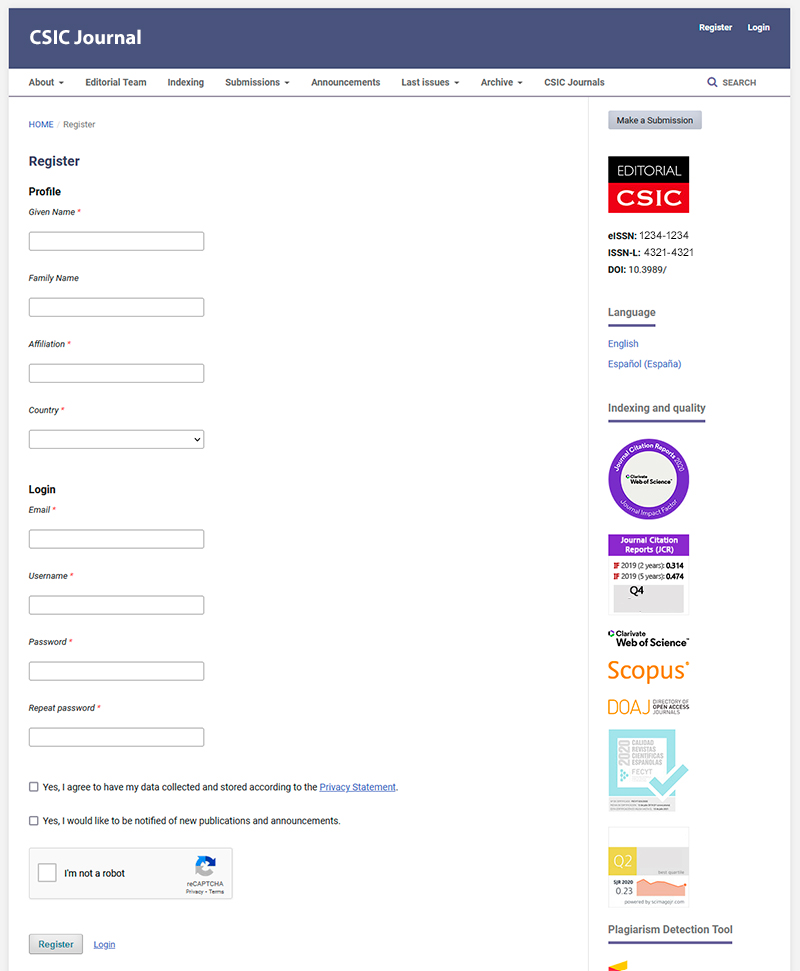
3.- You will receive a message with a link to activate your account at the provided email address. Once activated, you will be able to log in to your account with the credentials you created.
How to send an original manuscript to Estudios Geográficos
1.- On the magazine's website, log in by clicking on "Login":
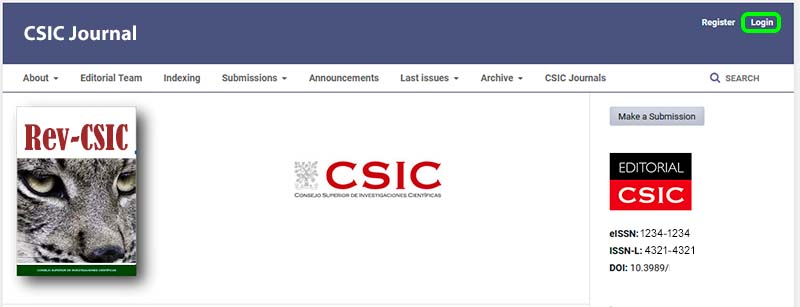
2.- Enter your username and password. Once you return to the magazine's homepage, click on the "Make a Submission" button:
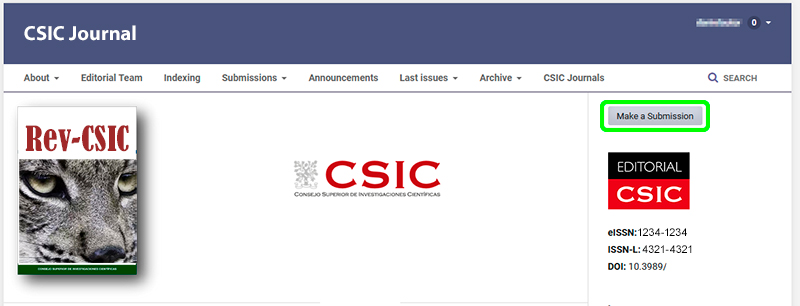
Before submitting, please review the "Submission Preparation Checklist" and read the "Author Guidelines", the "Copyright Notice" and the "Privacy Statement". When you have all the required documents ready, click on the link "Make a new submission".
In subsequent logins, you will be taken to your user dashboard. There press the ‘New Submission’ button to submit a new article. You will be shown any articles received and in process under the ‘My Queue’ tab):

3.- As you will see on the new submissions page, submitting a manuscript is a four-stage process, in addition to a final section with information on follow-up:
3.1.- "1. Start"
At this stage you must select the language in which the article is written and the section of the journal in which you think it would fit, you must indicate that you have prepared all the items on the "Submission requirements" list and, optionally, you may send comments to the editor. You must comply with the terms of the Copyright Statement and the collection and storage of your data as the author of the article in accordance with the Privacy Statement of the Consejo Superior de Investigaciones Científicas (CSIC).
Then press the "Save and continue" button.
3.2.- "2. Upload submission"
In this phase, the files that make up the article and its additional documentation will be uploaded to the management module.
There are three parts to upload each file. In the first one, we will select which component of the article we are going to contribute and we will upload the corresponding file. Once uploaded, click on the "Continue" button. In the second part we will see the file metadata, with the possibility to edit them, but we will click "Continue" without making this edition.
In the third part, select "Add Another File", going back to "1. Upload file" and, without modifying the default option "This is not a revision of an existing file", select the new "Article Component" identifying what it is and uploading the file. Click "Continue" until you reach, once again, step "3. Confirm". This process must be repeated until all the files have been sent, and only when all the material has been uploaded should the "Complete" button be selected.
If after "Completing" the submission we realise that we have forgotten to upload a file, we can do so by selecting the "Upload File" button located in the upper right-hand corner of the "2. Upload Submission" tab:

Once all the submission files have been uploaded, we will press the "Save and continue" button.
3.3.- "3. Enter Metadata"
In this phase the author will enter the metadata of the article according to the journal guidelines. These are:
- Title in Spanish and English. If the article is written in another language, it will be introduced first this language and then in English.
- Summary or abstract in the same languages as the previous item.
- List of contributors. Although it was not necessary when registering as a journal user, in this section it is compulsory for authors to have their ORCID identifier and affiliation correctly indicated. If necessary, the information of additional authors will be added using the link "Add contributor":

- Keywords. The article keywords will be inserted in both languages. The entire list cannot be copied, must be entered one term at a time pressing "Enter" after each one.
- Funding data. The entities that have supported the research published in the article must be indicated. After selecting "Add funder", the name of the funder should be inserted again, which will trigger an internal search that will return the institution standardised name and DOI. If the institution does not have a DOI, it will not be able to register in this field. After entering the grant numbers, click on "Save".
To finish this phase of entering metadata, click on the "Save and continue" button.
3.4.- "4. Confirmation" y "5. Next steps"
In this last phase we will confirm the submission metadata recording linked to the uploaded files. Before clicking on the "Finish Submission" button, we can go back to the previous phases and review the information and files provided to check that they are all correct.
Once we click on the "Finish Submission" button, the article will be sent to the journal and its staff will contact you to continue with the process, as indicated in the "5. Next Steps" section.
How to check a revision report and submit a revised version of a manuscript
Once your submission has been reviewed, the journal's staff will send you a review report. Once received, you must log in to the journal and, in the "Submissions" section of your dashboard, you will be able to check that your submission is in the Review phase and, if the editorial staff has requested, whether it is necessary to make any modifications or revisions to the manuscript:

By clicking on the title of your submission, you will be taken to the workflow of your submission and you will be able to check the information related to the its review. You will find the notifications that the editorial staff has sent you, the attachments that the reviewers may have attached and, if requested, the possibility to provide a new version of the manuscript with the requested modifications by clicking on the "Upload file" button:
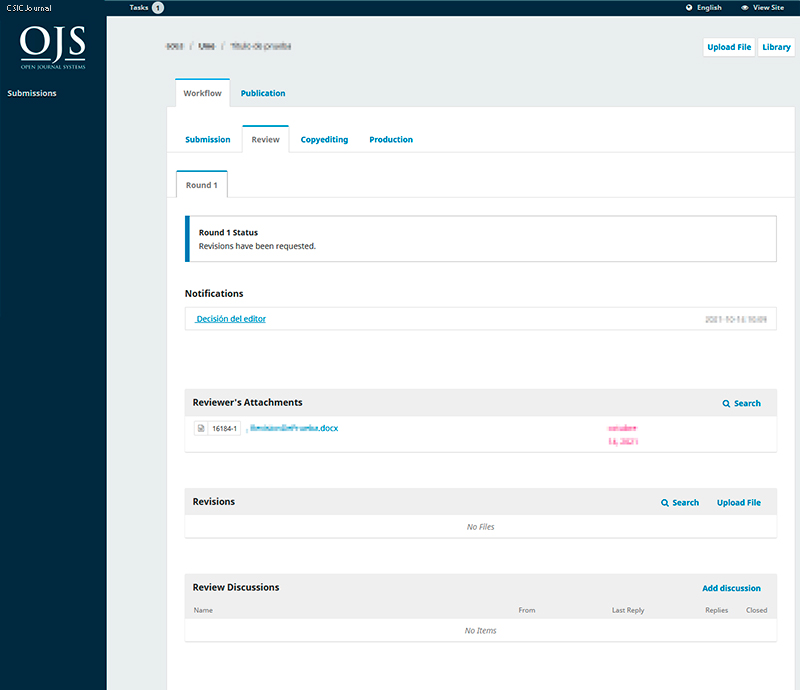
Research data policy
We recommend authors depositing data obtained from the research developed for the preparation of their article in repositories of recognized prestige, specific to the discipline or of a generalist nature. In any case, it must be a FAIR repository (Findable, Accessible, Interoperable, Reusable), preferably in open access.
There are several repositories destined to conserve and disseminate concrete data such as results of surveys, observations, interviews, simulations, automatically collected data, samples, models ... If necessary, authors can consult the Registry of Research Data Repositories re3data taking into account that each repository has its own deposit rules.
Those CSIC authors who would like to deposit their datasets in Digital.CSIC may do so by following these guidelines. They can use the Servicio de Archivo Delegado made available by the Technical Office of DIGITAL.CSIC and the Red de Bibliotecas CSIC.
DIGITAL.CSIC generates DOIs for datasets and associated software and is certified as data repository in re3data and Repository Finder. More information at Política de datos en Digital.CSIC.
If the author has deposited datasets in a repository, he should mention it in the article providing a brief description of the type of data deposited, the name and URL of the repository, the identification code and the data of the license for use and distribution. This information must be included at the end of the article, immediately before the bibliographic listing, under the heading "Data availability".
Download HERE the Good Practice Code in PDF
Download HERE the Authorship Form in PDF
Copyright Notice
© CSIC. Manuscripts published in both the printed and online versions of this Journal are the property of Consejo Superior de Investigaciones Científicas, and quoting this source is a requirement for any partial or full reproduction.All contents of this electronic edition, except where otherwise noted, are distributed under a “Creative Commons Attribution 4.0 International” (CC BY 4.0) License. You may read here the basic information and the legal text of the license. The indication of the CC BY 4.0 License must be expressly stated in this way when necessary.
Self-archiving in repositories, personal webpages or similar, of any version other than the published by the Editor, is not allowed.
Privacy Statement
The Spanish National Research Council (CSIC) has a record of data processing activities. Data collected through this form will be incorporated and processed in the “Gestión de las actividades de producción y distribución de las publicaciones del CSIC” treatment activity of Editorial CSIC, in order to manage the requested service. It is the responsibility of Editorial CSIC to manage this record. If you wish to exercise your rights, please contact us through the contact address Vitruvio, 8, 28006 Madrid, Spain, e-mail address publ@csic.es. Data processing is legitimized by the consent of the affected. The data may not be transferred to third parties except in the cases provided for in current regulations on the protection of personal data. You have the right to file a claim with the Spanish Data Protection Agency. You have the right to withdraw your consent. In the event that you wish -or want to exercise the rights of access, deletion, rectification, limitation or portability- you can do so through the following form. You can also contact the CSIC Officer for Data Protection via email: delegadoprotecciondatos@csic.es

